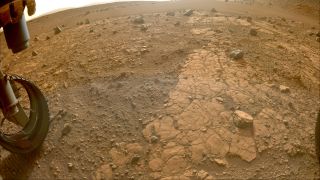NASA's Perseverance Mars rover hunts tantalizing bedrock that could hide evidence of life
The rover is searching Yori Pass at the base of the Mars' Jezero Crater river basin for fine-grained sandstone that may have been carried by water.

NASA's Perseverance rover has reached an area at the base of Mars' Jezero Crater where it will hunt for rocks created when flowing water deposited fine-grained sediments. Sealed within these sedimentary rocks, researchers hope, could be organic molecules that are the signs of ancient life.
For months, NASA scientists have been eager to search the area, dubbed "Yori Pass," within Mars' Jezero Crater — an ancient fan-shaped river delta that formed about 3.5 billion years ago at the convergence of a Martian river and a lake. The site caught attention after scientists spotted a rock there that resembles a sandstone rock the Perseverance rover collected a sample from in July. Collecting rock samples is an integral part of Perseverance's goal to search Jezero Crater for any signs that life once existed on the Red Planet — for any element, molecule, substance or feature that is characteristic of life.
"We often prioritize the study of fine-grained sedimentary rocks like this one in our search for organics and potential biosignatures," Perseverance deputy project scientist at NASA's Jet Propulsion Laboratory in California, Katie Stack Morgan, said in a statement. "What's especially interesting about the Yori Pass outcrop is that it is laterally equivalent with 'Hogwallow Flats,' where we found very fine-grained sedimentary rocks."
Related: 12 amazing photos from the Perseverance rover's 1st year on Mars
The geology at hand is exciting for the team because scientists consider these fine-grained rocks to have the best chance at preserving evidence of life because they contain a higher concentration of clay materials that can protect large organic molecules from harsh solar radiation, preventing them from degrading.
Stack Morgan said that the Yori Pass rock bed is similar to Hogwallow Flats — also called "the Bacon Strip" due to its light-colored striped rocks — because it is located at the same elevation and both have a large, traceable footprint which is visible on the Martian surface.
The Perseverance rover has been exploring the Jezero Crater since it touched down on Mars in February 2021 during a daring descent the spacecraft filmed.
Get the Space.com Newsletter
Breaking space news, the latest updates on rocket launches, skywatching events and more!
Since then, Perseverance has collected 14 rock-core samples and an atmospheric sample, which are stored in the belly of the rover. The rover's sample-collecting mission began in September 2021, when it successfully drilled free its first pencil-thin rock core from Jezero Crater and placed it in an airtight titanium sample tube.
These samples form a key element of the planned joint NASA/European Space Agency (ESA) sample-return mission, which aims to send a spacecraft to Mars, collect sealed-up Martian samples from Perseverance, and return them to Earth for in-depth analysis.
Follow us on Twitter @Spacedotcom or on Facebook.
Join our Space Forums to keep talking space on the latest missions, night sky and more! And if you have a news tip, correction or comment, let us know at: community@space.com.

Robert Lea is a science journalist in the U.K. whose articles have been published in Physics World, New Scientist, Astronomy Magazine, All About Space, Newsweek and ZME Science. He also writes about science communication for Elsevier and the European Journal of Physics. Rob holds a bachelor of science degree in physics and astronomy from the U.K.’s Open University. Follow him on Twitter @sciencef1rst.
Most Popular

